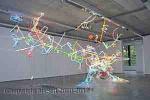Anselm Reyle
Anselm Reyle
Place: Tübingen
Born: 1970
Biography:
Anselm Reyle is an artist based in Berlin. He is known for his often large-scale abstract paintings and found-object sculptures.
Anselm Reyle was born in Tübingen in 1970. He studied at the Staatliche Akademie der Bildenden Künste, Stuttgart and at the Staatliche Akademie der Bildenden Künste, Karlsruhe. He moved to Berlin in 1997 where he founded a studio cooperation with John Bock, Dieter Detzner, Berta Fischer and Michel Majerus. From 1999 to 2001 Reyle has been working together with Claus Andersen and Dirk Bell for the artists' co-operative gallery "Andersen’s Wohnung" and "Montparnasse" with Dirk Bell and Thilo Heinzmann. After having held a position as guest-professor at the Staatlichen Akademie der Bildenden Künste, Karlsruhe, Universität der Künste, Berlin and the Hochschule für bildende Künste Hamburg, Reyle became a professor in Drawing/Painting in Hamburg in 2009. In 2014 the artist announced to take an exhibition and production break of indeterminate duration.
Anselm Reyle took an early interest in landscape design and music before finally homing in on painting and sculpture. Characteristic of his work are various found objects that have been removed from their original function, altered visually and recontextualized. Reyle works in different media, utilizing strategies of painting, sculpture and installation and working in serial, structured work groups. The artist uses a vast and diverse group of materials taken from both traditional art and commercial milieus including colored foils from shop window displays, acrylic medium and pastes, automotive lacquer, and useless everyday garbage taken from urban areas. By removing these materials from their contexts and masking their original function, Reyle varies the degree to which each retains its respective visual reference. Utilizing formulas of appropriation the work lets the viewer shift between moments of identification of individual elements within the work, and periods of alienation due to their new context. Even the exhibition and work titles are very often citations from different fields, such as song texts; they function as objets-trouvés of the artist´s repertoire.
One of Anselm Reyle’s best known work series are his “foil paintings” - the highly celebrated abstract works that are created using foil arranged and installed in colored perspex boxes. Their shimmering materiality seduces the recipient´s eye and stimulates their sense of touch, at the same time the perspex box denies any possibility of a tactile experience. The dynamic surface of these works emphasizes their objecthood and spatial presence, the fragile folded foil forms contrasting with their rigid geometry.
Despite Reyle’s ongoing commitment to abstraction, he is currently experimenting with representational motives. Indeed, in his recent works, Reyle playfully explores the origin of the figure by explicitly referencing the tradition of “paint-by-numbers,” thereby revealing the way abstract forms can coalesce and become recognizable subjects from life. By using a strategy such as seen in paint-by-numbers, the subject matter is dissected in single, serially numbered parts like a puzzle where each number is assigned a certain color that is in interaction with other fields. These are then filled in with materials or colors that the viewer can recognize from the Reyle repertoire, as in the stripe paintings or Otto-Freundlich-series. This juxtaposition creates the impression of a plastic relief with a wide range of surface textures which directly appeals to the viewer’s sense of touch.
The most well-known sculptures of Anselm Reyle are the so-called „African sculptures“. The original forms and titles for these work groups are borrowed from tourist markets and the kitschy flea market handicrafts – often made from soapstone – that are sold as clichés of African sculpture. Set on a low-lying Macassar wooden plinth, his piece Harmony (2007) is based on a small soapstone sculpture his mother purchased on a visit to Africa. While cheap and derivative, in their formal conception these forms recall the prominent abstract sculptors of modern art like Hans Arp, Alexander Archipenko and Henry Moore. The distinct influence of European sculpture on these African knick-knacks manifests itself in this suggested prototype of modern plastic art. Reyle uses traditional techniques; enlarging the original found object before casting it in bronze, chroming and lacquering it. This process creates a work with great tension as the traditional hand sculptural technique is contrasted with the highly engineered bronze work. The viewer’s foreknowledge of the techniques that Reyle underwent to create and transform the object is vital to communicate this intentional paradox.
While he is well known for his use of unusual materials and physical alterations, Reyle’s work is grounded in art historical schools of abstraction dating from the early 20th century, including Art Informel, Cubism, Op-Art, Minimalism and Pop Art. And while Reyle often works within the tradition of object trouvés he does not rely on appropriation as in the work of, for example, Louise Lawler or Elaine Sturtevant. Instead Reyle uses his highly refined aesthetic vocabulary to question the role excess plays in the postmodern market by collapsing and mixing these various traditions in unexpected ways. Indeed, by exploiting both historic languages and simultaneously developing an evolving vocabulary of new industrial practices and mass production methods he is able to reflect upon the various “blind alleys of modernity.”
More...
Wikipedia link: Click Here

